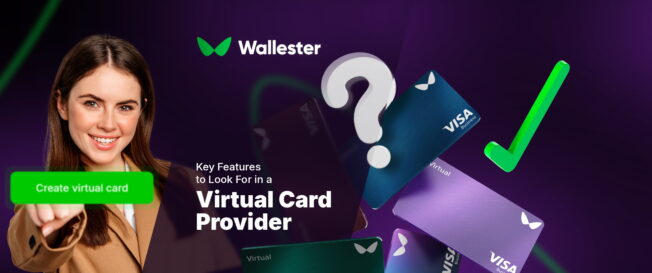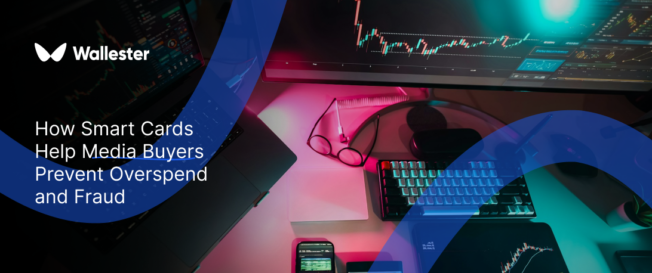Agencies often manage payments for several projects and clients at once. When everything runs through the same cards and accounts, it becomes harder to keep things clear. Virtual cards help separate these payments in a practical way. You can create a card for each client or task, set limits, and track what was spent. This reduces confusion and makes it easier to handle day-to-day operations without adding more manual work.
What is a virtual card?
A virtual card is a payment card that exists only online. It has all the standard details you’d find on a physical card, such as a number, expiration date, and security code, but it is created and used through a digital platform. You can use it for online transactions, subscriptions, or any payment where a physical card isn’t required.
Unlike traditional cards, virtual cards can be generated quickly and managed with more flexibility. You can set rules for how and where they’re used, adjust limits, or cancel them at any time. This is especially useful for agencies that handle payments for multiple clients or projects. Creating separate cards helps keep budgets organised and prevents overlap between accounts. It also reduces the need for manual tracking and lowers the risk of errors.
How does a virtual card work?
Virtual cards work by generating a set of card details that can be used for online payments, just like a regular card. When you request one from your provider, the system creates a card number, expiration date, and security code, then links them to your main business account. These details can be used for one-time purchases, recurring payments, or any transaction that does not require a physical card.
Each virtual card is issued with specific rules attached. You can set spending limits, restrict which merchants can charge the card, or define how long the card remains active. Some cards are created for single use, while others can be used repeatedly within a set timeframe. This flexibility allows agencies to manage payments across different projects, teams, or clients with more clarity and control.
Virtual cards are often part of broader financial tools. Many platforms connect directly with accounting or expense management systems, so every transaction is recorded automatically. This helps with reporting, budget control, and reconciliation. Security is also built in. Technologies like tokenisation and encryption protect the card details during use and help prevent misuse or data theft compared to traditional cards.
Further Reading: The Complete Guide to Payment Cards for Media Buyers
Virtual credit cards vs. Physical credit cards
The main difference between virtual and physical credit cards is how they’re issued and used. Physical cards are made of plastic and can be used in person, online, at ATMs, or anywhere that accepts card payments. Virtual cards are created online and used digitally, often through a browser or mobile wallet.
In terms of security and control, virtual cards offer several advantages. Each card is issued with its own set of details, which can be changed or cancelled without touching the underlying account. This helps limit exposure if card data is compromised. Virtual cards also allow for more specific settings around how and where they’re used.
Here’s how the two compare:
| Feature | Virtual Credit Cards | Physical Credit Cards |
| Format | Digital only | Plastic card |
| Usage | Online and mobile wallets | In-person and online |
| Security | Unique details per card, tokenised data | Same number reused, higher exposure risk |
| Controls | Per-card limits, expiration, merchant rules | Basic limits, fewer restrictions |
| Replacement | Instant | Requires shipping, delays possible |
| Ideal for: | Project/client-specific payments | General or in-person purchases |
For agencies managing digital transactions, project-based budgets, or recurring payments, the flexibility of virtual cards often provides better oversight.
Further Reading: Virtual Cards vs. Physical Cards: What’s Better for Business?
Types of virtual cards
Virtual cards are available in several types, each suited to different business needs and payment scenarios. For agencies, choosing the right type of card can help improve how spending is organised and controlled.
Single-use virtual cards are created for one-time transactions and automatically expire after the payment is completed. These disposable cards are useful for one-off purchases, especially when working with new suppliers or unfamiliar vendors. Since the card details are no longer valid after use, they carry a lower risk of being misused later.
Multi-use virtual cardsallow for repeated use over a specific period. They are a good fit for subscriptions, regular supplier payments, or long-term projects. These cards can be configured with limits and restrictions while still allowing for the convenience of ongoing payments without needing to issue a new card each time.
Department-specific virtual cards give agencies the option to assign cards to specific teams or functions. A marketing team, for example, can have a card dedicated to ad spend, while an operations team might use another for office-related expenses. This kind of structure helps separate budgets, keeps records clear, and simplifies internal tracking.
Project-based virtual cards are ideal for agencies working with several clients or projects at once. A separate card can be issued for each project, with defined spending limits and approved merchants. This setup supports more accurate billing, better reporting, and clearer tracking of costs tied to specific work.

Is it important to provide virtual card payment options?
Virtual card payment options are relevant for agencies that manage multiple clients, projects, and recurring payments. As more businesses move away from traditional payment methods, clients now expect faster, safer, and more flexible options.
Offering virtual card payments reflects a professional and organised approach to handling finances. It shows clients that the agency can adapt to modern tools and manage budgets with precision. Internally, virtual cards also help solve common issues related to tracking, accountability, and risk.
Some of the key advantages include:
- Lower administrative burden. No need to manage physical cards or wait for replacements.
- Clear cost tracking. Real-time expense monitoring makes it easier to see where and how money is spent.
- Improved security. Virtual cards reduce the risk of fraud, misuse, or data exposure.
- Better client experience. Agencies can assign cards per client or project, helping with reporting and billing.
- Faster handling of payments. Funds move more efficiently, with fewer delays or errors.
Use cases of virtual cards
Virtual cards support a wide range of everyday tasks across different types of agencies. By assigning cards to specific teams, projects, or purposes, agencies can manage payments with better clarity and control.
Marketing agencies use virtual cards to manage advertising budgets across multiple platforms. Issuing separate cards for Google Ads, Facebook, and other media channels allows for accurate budgeting and direct cost attribution to each client. Spending limits help prevent overspend, and automated tracking supports precise billing and internal reporting.
Travel agencies, including those handling corporate travel, issue virtual cards for individual bookings. This helps prevent fraud, keeps records clear, and allows for quick matching between payments and reservations. Expiration dates can align with travel schedules, and integration with booking platforms supports a smoother workflow.
Creative agencies working on several projects at once assign cards per project to separate costs and avoid confusion. Each card can have limits and merchant rules tailored to the project scope. This setup supports correct cost allocation and keeps client work financially transparent, especially in fixed-fee contracts.
Digital agencies use virtual cards to manage subscriptions, hosting services, and other digital tools. Assigning specific cards to each service prevents disruption when a card changes or expires. It also provides a full view of regular charges and active services across the agency.
Procurement teams use virtual cards to handle vendor payments without relying on shared company cards. Cards can include merchant restrictions and fixed limits, giving staff the freedom to purchase approved items within set boundaries. This also helps maintain oversight and shortens approval times.
Further Reading: Top Use Cases for Virtual Cards in Business
7 Virtual card platform features for agencies
Choosing the right virtual card platform means focusing on features that support real, everyday use. For agencies working with clients, budgets, and multiple teams, the right tools make payment management more structured and reliable.
- Instant card creation and management
Agencies often need to issue cards without delay. A strong platform allows users to generate cards through a web interface or mobile app. Card details become available immediately, and spending settings can be applied as part of the setup. This is important when making time-sensitive purchases or setting up payments for new projects.
- Spending limits and usage rules
The platform should provide a way to control how each card is used. This includes setting limits per transaction, per day, or over longer periods. Rules can also be applied to restrict usage to specific merchants, regions, or categories. These settings prevent unauthorised spending and keep budgets aligned with actual needs.
- Real-time tracking and transaction records
The system must show each transaction as it happens, with a timestamp, merchant name, and card ID. This allows finance teams to follow activity closely and identify unusual charges without delays. No extra tools are needed to review spending across teams or accounts.
- Integration with existing software
Many agencies already use tools for accounting, approvals, and project tracking. The card platform should connect directly with these systems. This allows transaction data to move between platforms without manual entry. It also means that records stay consistent across finance, operations, and client-facing teams.
- Support for multiple currencies
Agencies working across countries need the ability to issue cards in different currencies. The platform should allow international payments, apply clear exchange rates, and show fees before transactions are confirmed. Holding balances in different currencies can also make payments to suppliers and partners more straightforward.
- Strong security controls
The platform must protect card information during and after every transaction. Security features should include encryption, tokenisation, and notifications for flagged activity. If something goes wrong, a card must be easy to block or remove without waiting. These protections apply across all users and cards in the system.
- Multi-user access and permissions
As the agency grows, more people need access to card tools. The platform should support different roles. For example, a finance lead may approve all new cards, while team leads issue cards for their departments. This keeps access organised without relying on constant supervision.
Benefits of virtual cards for agencies
Virtual cards offer a practical way to manage agency finances with more control, less friction, and better visibility. Below are key benefits that apply across teams and operations:
- Clearer cash flow management
Transactions appear as soon as they’re made, so balances stay up to date. This avoids delays that come with traditional cards and gives agencies a more accurate view of available funds, especially useful when income varies month to month.
- Fewer manual processes
Virtual cards cut down on routine admin work. Receipts are logged digitally, transactions are assigned to categories automatically, and data can be shared directly with accounting tools. This lets teams spend less time on reconciliation and more time on billable work.
- Stronger control over risk
Agencies can issue cards with strict limits, block certain vendors, or cancel a card instantly if something looks off. Single-use cards are ideal for new suppliers or short-term projects. This approach adds a layer of protection that traditional cards lack.
- Better reporting and client visibility
Each card can be linked to a specific project or client, which keeps records tidy and transparent. Finance teams can trace every charge back to its source, which improves accuracy in invoices and internal reviews.
- Easy setup for new teams or projects
New cards can be created in seconds. Agencies don’t need to wait for plastic, and cards can be assigned by team, role, or task. This is especially useful when onboarding new staff, starting a client engagement, or scaling during high-demand periods.
Implementing virtual cards for your business
Switching to virtual cards doesn’t need to be difficult, but it should be done with care. A slow, structured rollout keeps your team comfortable and your operations steady.
Step 1: Review how you currently pay
Start by looking at how your agency handles payments today. Map out where money goes, how often, and who is responsible. Look for areas where physical cards or bank transfers cause delays, confusion, or extra work. Online purchases, recurring charges, and project-related spend are usually the easiest places to begin.
Step 2: Choose what to move first
Not everything has to change at once. Pick a few categories where virtual cards will clearly save time or offer more control. This might include software subscriptions, ad platform budgets, or one-off supplier payments. Choosing clear, limited use cases makes testing smoother and results easier to measure.
Step 3: Compare providers
Find a platform that fits your agency’s size, setup, and workflow. Check how it connects to your accounting system, what security measures it uses, how cards are issued and managed, and how fees are charged. Don’t rush. Test demo versions or trial accounts if they’re available. A little testing up front prevents bigger problems later.
Step 4: Train your team
Virtual cards are a tool – and like any tool, they only work when people know how to use them. Walk team members through how to request, use, and manage cards. Show them how to track expenses, follow limits, and stick to approval flows. Explain how these changes make daily work easier, not harder.
Step 5: Roll it out slowly
Start small. Give access to one team, one department, or one project. Watch how it goes, then expand. Use early feedback to tweak settings, catch mistakes, and write down your process. A slow rollout means fewer surprises and a cleaner handover when the whole agency is ready.
Step 6: Check how it’s going
Once things are up and running, keep an eye on usage. Track how cards are used, where errors show up, and what your team still finds confusing. Use built-in reporting tools to monitor spend, check limits, and spot trends. Keep asking: is this making our work smoother? What should we adjust?
Further Reading: How to Implement Virtual Cards in Your Company
Why use Wallester’s virtual cards?
Wallester built its business product around real needs of agencies and growing companies. This platform delivers several core benefits that matter most for specialists managing multiple budgets, currencies, and stakeholder teams:
- Instant issuance and bulk allocation
You can generate virtual cards immediately with no need to wait for physical delivery. The free plan includes up to 300 cards, with higher tiers allowing thousands more.
- Global reach and multi-currency support
Cards connect via Visa, work anywhere that accepts digital payments, and support multiple currencies – with clear exchange rates and no surprises.
- Comprehensive spending settings
Apply precise limits per card, define merchants or categories, configure active windows, and block unwanted vendors – all available directly from the user interface.
- Security built into every transaction
Each card uses encryption and tokenisation. You can freeze or revoke a card instantly and receive real-time alerts when activity deviates from your setup .
- Seamless platform integrations
Wallester integrates with accounting systems, expense tools, and custom setups via API, syncing card data automatically with your existing workflows.
- Free physical cards and white-label options
The platform supports unlimited physical cards alongside your virtual cards. You can also create branded, white-label products for clients or internal teams.
Wallester’s structure accommodates business transitions without disruption. By pairing digital flexibility with strong controls and global compatibility, it’s a tool built to match how agencies operate today.Start using virtual cards that fit your workflow. Explore Wallester Business and see how it can support your team, clients, and projects from day one.


